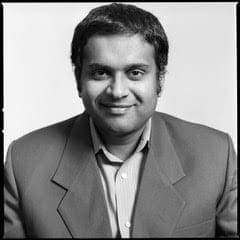
Surjeet Rajendran’s scholarly interests are in theoretical physics with a strong focus on physics beyond the standard model. Prior to coming to Hopkins, he was the Henry Shenker Professor of Physics at the University of California, Berkeley. He holds a PhD in physics from Stanford University.
IFT Colloquium: Wednesday, March 26th at 3:00 PM in 2205 NPB
Opening up the Gravitational Wave Spectrum
The historic discovery of gravitational waves by LIGO has initiated a new era of astronomy, permitting us to observe the universe through new eyes. LIGO is sensitive to gravitational waves at frequencies above 40 Hz. Much like the case of electromagnetism, there is a strong science case to observationally probe other parts of the gravitational wave spectrum. Significant advances on this front have been made in the mHz band by the LISA collaboration and the nHz range by the NanoGRAV collaboration. How might be probe other gravitational wave frequencies? In this talk, I will discuss the use of atom interferometers to probe gravitational waves in the 1 Hz band. I will also explore the potential use of asteroids as test masses to detect gravitational waves at micro Hz frequencies and the possible use of astrometry in the nHz – micro Hz regime.
Research Seminar: Thursday, March 27th at 1:30 PM in 2205 NPB
The Classical Equations of Motion of Quantized Gauge Theories
The classical equations of motion of a quantum field theory are obtained by minimizing an action. When we apply this procedure to a gauge theory, there is an interesting issue. The variation of the classical action along a gauge direction is zero. Thus, one of the traditional classical equations that are obtained by such a variation does not actually exist. Alternately, the quantum theory is defined by gauge fixing the classical action. This gauge fixed action is slightly different from the classical action and it can be shown that this procedure also results in some classical equations not existing. The missing equations are the constraint equations of the gauge theory – Coulomb’s law in the case of electromagnetism and the time components of Einstein’s equations in the case of gravity. What does this imply? We show that even though the constraint equations are not obeyed, the time derivatives of the constraints are automatically satisfied by the quantum evolution. A quantum state that does not obey the constraint can be consistently time evolved. The time evolution of this quantum state would be identical to that of a classical state that contains some “dark” object i.e. dark charge in the case of electromagnetism and dark matter in the case of gravity. But, there is no new physics associated with this “dark” object – it is simply a choice of initial quantum state of the theory. In this talk, I will describe these effects in the simple model of “mini-superspace” i.e. homogeneous quantum cosmology. As a consequence, we will show that one can obtain natural time evolution in quantum cosmology and that the time evolution of the quantum state of the universe need not be described by the Wheeler deWitt equation which requires the universe to be in an energy eigenstate thus forcing the quantum state of the universe to be timeless.